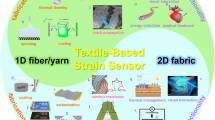Abstract
Carbon-based electrically conductive polymer composites have been considered as promising materials for piezoresistive pressure and strain sensors. The objective of this work is to investigate the behaviors of wood-derived biochar-filled polyvinyl alcohol (PVA) composites as pressure sensors. Composites of polyvinyl alcohol and wood-derived biochar were prepared by a solution casting method. The research found that with elevated pressure from 0 to 358 kPa, the electrical resistance of PVA/biochar composite sensors with 8, 10, and 12 wt% biochar content (to 10% PVA solution by weight) gradually decreased by 92, 98, and 99%, respectively. Also, the effects of sensor thickness (0.40, 0.50, and 0.60 mm) and temperature (from −20 to 70 °C) were investigated. Results indicated that effect of thickness was most influential in the 8 wt% PVA/biochar sensors. Higher temperature (40–70 °C) enhanced the sensor voltage output, while lower temperature (−5 to −20 °C) reduced the piezoresistive effects.







Similar content being viewed by others
References
Lacasse M-A, Duchaine V, Gosselin C (2010) Characterization of the electrical resistance of carbon-black-filled silicone: application to a flexible and stretchable robot skin, IEEE ICRA, pp 4842–4848
Wang Z, Ye X (2013) A numerical investigation on piezoresistive behavior of carbon nanotube/polymer composites: mechanism and optimizing principle. Nanotechnology 24:265704
Schwartz G, Tee BC-K, Mei J, Appleton AL, Kim DH, Wang H, Bao Z (2013) Flexible polymer transistors with high pressure sensitivity for application in electronic skin and health monitoring. Nat Commun 4:1859
Dusek J, Woo ME, Lang J (2014) Carbon black-PDMS composite conformal pressure sensor arrays for near-body flow detection. IEEE, pp 1–7
Wang L, Ding T, Wang P (2009) Influence of carbon black concentration on piezoresistivity for carbon-black-filled silicone rubber composite. Carbon 47(14):3151–3157
Ding T, Wang L, Wang P (2007) Changes in electrical resistance of carbon-black-filled silicone rubber composite during compression. J Polym Sci, Part B: Polym Phys 45(19):2700–2706
Wang L, Ma F, Shi Q, Liu H, Wang X (2011) Study on compressive resistance creep and recovery of flexible pressure sensitive material based on carbon black filled silicone rubber composite. Sens Actuators, A 165(2):207–215
Wang P, Ding T (2010) Conductivity and piezoresistivity of conductive carbon black filled polymer composite. J Appl Polym Sci 116(4):2035–2039
Wang L, Ding T, Wang P (2007) Effects of conductive phase content on critical pressure of carbon black filled silicone rubber composite. Sens Actuators, A 135(2):587–592
Knite M, Teteris V, Kiploka A, Kaupuzs J (2004) Polyisoprene-carbon black nanocomposites as tensile strain and pressure sensor materials. Sens Actuators, A 110(1–3):142–149
Lehmann J, Joseph S (2009) Biochar for environmental management: science and technology. Routledge, Earthscan
Mochidzuki K, Soutric F, Tadokoro K, Antal MJ (2003) Electrical and physical properties of carbonized charcoals. Ind Eng Chem Res 42(21):5140–5151
Liu W, Zhao H, Inoue Y, Wang X, Bradford PD, Kim H, Qiu Y, Zhu Y (2012) Poly(vinyl alcohol) reinforced with large-diameter carbon nanotubes via spray winding. Compos A Appl Sci Manuf 43:587–592
Layek RK, Samanta S, Nandi AK (2012) The physical properties of sulfonated graphene/poly(vinyl alcohol) composites. Carbon 50:815–827
Tang Z, Lei Y, Guo B, Zhang L, Jia D (2012) The use of rhodamine B-decorated graphene as a reinforcement in polyvinyl alcohol composites. Polymer 53:673–680
Shang S, Gan L, Yuen CWM, Jiang S, Luo NM (2015) The synthesis of graphene nanoribbon and its reinforcing effect on poly(vinyl alcohol). Compos A Appl Sci Manuf 68:149–154
Nan N, De Vallance DB, Xie X, Wang J (2016) The effect of bio-carbon addition on the electrical, mechanical, and thermal properties of polyvinyl alcohol/biochar composites. J Compos Mater 50:1–8
American Society for Testing and Materials (2015) Standard test methods for proximate analysis of coal and coke by Macro thermogravimetric analysis. Book of standards. ASTM, West Conshohocken, PA
Nan N (2016) Development of polyvinyl alcohol/wood-derived carbon thin films: influence of processing parameters on mechanical, thermal, and electrical properties. Retrieved from West Virginia University library data
Wang L, Ding T, Wang P (2008) Effects of compression cycles and precompression pressure on the repeatability of piezoresistivity for carbon black-filled silicone rubber composite. J Polym Sci, Part B: Polym Phys 46(11):1050–1061
Acknowledgements
Appreciation is expressed to Dr. Jinxing Wang, professor of Wood Science and Technology, Director of Biomaterials and Wood Utilization Research Center, Davis College School of Natural Resources, WVU, to Dr. Edward Sabolsky, associate professor of Benjamin M. Statlercollege of Engineering and Mineral Resources, Department of Mechanical and Aerospace Engineering, WVU, and to Dr. Xinfeng Xie, Division of Forestry and Natural Resources, WVU, for their technical assistance and the equipment provided.
Funding
This work was supported by the USDA/NIFA McIntire-Stennis Program (Grant No. WVA00116). Any opinions, findings, conclusions, or recommendations expressed are those of the authors and do not necessarily reflect the view of USDA/NIFA.
Author information
Authors and Affiliations
Corresponding author
Rights and permissions
About this article
Cite this article
Nan, N., DeVallance, D.B. Development of poly(vinyl alcohol)/wood-derived biochar composites for use in pressure sensor applications. J Mater Sci 52, 8247–8257 (2017). https://doi.org/10.1007/s10853-017-1040-7
Received:
Accepted:
Published:
Issue Date:
DOI: https://doi.org/10.1007/s10853-017-1040-7




